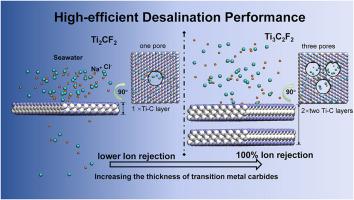由过渡金属碳化物厚度控制的高效多孔 MXene 海水淡化膜
IF 8.4
1区 工程技术
Q1 ENGINEERING, CHEMICAL
引用次数: 0
摘要
MXene 膜具有缓解全球淡水危机的巨大潜力。本文提出了一种通过调节纳米多孔 MXene 膜的过渡金属碳化物厚度来提高海水淡化性能的新策略。通过分子动力学(MD)模拟研究了多孔 MXene 的厚度,包括 Ti2CF2、Ti3C2F2 和 Ti4C3F2。结果表明,多孔 MXene 膜可以实现高效脱盐。水密度分布表明,更多的水聚集在较厚的过渡金属碳化物层中,导致水通量较差;平均电荷分布表明,过渡金属层在有效排斥 Na+ 离子/捕获 Cl- 离子方面起着至关重要的作用。多层多孔膜被用来改善海水淡化性能。孔隙数量可提高透水性,而多层膜则可改善离子阻隔性。具有三个纳米孔的双层 Ti3C2F2 膜实现了近两倍的水通量,并保持了 100% 的离子抑制率。我们的工作表明,纳米多孔 MXene 膜为消除现有设计缺陷提供了一种前瞻性策略,为海水淡化半透膜行业提供了一种创新方法。本文章由计算机程序翻译,如有差异,请以英文原文为准。

Highly efficient porous MXene desalination membranes controlled by the thickness of the transition metal carbides
MXene membrane has the vast potential to alleviate the global freshwater crisis. Herein, a new strategy for improving the desalination performance is proposed through tunable the thickness transition metal carbides of the nano-porous MXene membrane. The thickness of porous MXene is investigated by molecular dynamics (MD) simulation, including the Ti2CF2, Ti3C2F2, and Ti4C3F2. The results show that the porous MXene membrane can reach highly efficient desalination. The water density distribution reveals that more water gathers in the thicker transition metal carbides layer, contributing to the poor water flux; the average charge distribution indicates that the transition metal layer plays an essential role in effectively rejecting Na+/trapping Cl− ions. Multilayered porous membranes are explored to improve the trade-off desalination performance. The number of pores enhances the water permeability, and the multilayers improve the ion rejection. The two-layered Ti3C2F2 membrane with three nanopores achieves nearly doubled water flux and keeps 100 % ion rejection. Our work reported that the nano-porous MXene membrane offers a prospective strategy to eliminate the current design defects, which provides an innovative method for the desalination semipermeable membrane industry.
求助全文
通过发布文献求助,成功后即可免费获取论文全文。
去求助
来源期刊

Journal of Membrane Science
工程技术-高分子科学
CiteScore
17.10
自引率
17.90%
发文量
1031
审稿时长
2.5 months
期刊介绍:
The Journal of Membrane Science is a publication that focuses on membrane systems and is aimed at academic and industrial chemists, chemical engineers, materials scientists, and membranologists. It publishes original research and reviews on various aspects of membrane transport, membrane formation/structure, fouling, module/process design, and processes/applications. The journal primarily focuses on the structure, function, and performance of non-biological membranes but also includes papers that relate to biological membranes. The Journal of Membrane Science publishes Full Text Papers, State-of-the-Art Reviews, Letters to the Editor, and Perspectives.
 求助内容:
求助内容: 应助结果提醒方式:
应助结果提醒方式:


